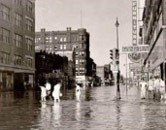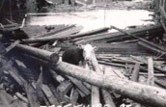Floyd River Flood of 1953
June 8, a Monday morning, seemed to be shaping up to be a pleasant sunny spring day. Sunday had been a day of heavy rain, but the sky had cleared. The Floyd was running high that morning, but no one suspected the disaster that would arrive in the middle of the morning.
The city didn't realize the amount of rain that had fallen in the northern area of the Floyd drainage basin. Between 8 and 11 inches of rain had fallen in the Sheldon area. A swift moving wall of water approached the city. By 11:00 that morning, Leeds was flooded. On Floyd Avenue, only the tops of cars could been seen. Volunteers came from all over town to help rescue stranded people. 41st Street, a gravel road, was on higher ground and not flooded. This was the only way for people to enter or leave the area.
After the flood waters receded, the city began a massive clean up. More than 500 hundred people were employed that summer to help with the enormous job.
The loss of life made this the worst flood ever. Because of the suddenness of the unexpected flood, many people in the Springdale area were caught completely by surprise. Fourteen people lost their lives, including 3 children.
Water spread as far east as the Badgerow Building and covered all of the fourth street area. A large number of people were stranded on the Fourth Street viaduct and neighboring buildings. Merchants in the Fourth Street area scrambled to move their merchandise to upper levels of their buildings. Many downtown retail businesses such as Morey's Clothing, Weatherwax Inc., and Larson Clothing were severely damaged. Metz Bakery on Highway 75 and the Tolerton & Warfield warehouse were in shambles. The damage was estimated at over ten million dollars.
As usual, one of the hardest hit areas was the stockyards. Like the 1892 flood, the wall of water that swept through the area did massive damage.
The city's water supply was damaged. Several pumping stations were flooded and unusable in the days after the flood. The city was placed under severe water restrictions. People caught breaking the rules had their water shut off until the damage was fixed. At one time, the city was down to four hour's supply.





